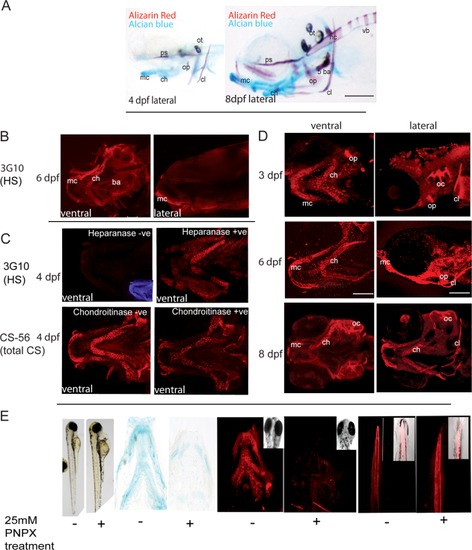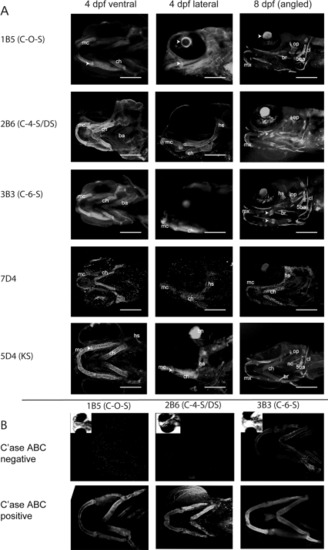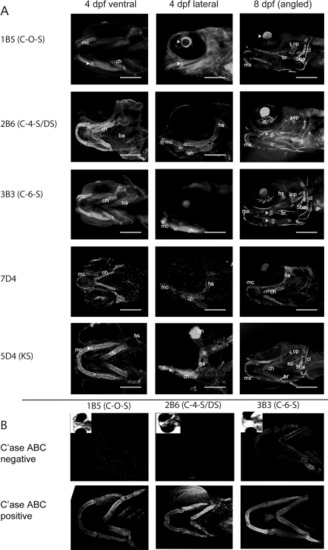- Title
-
Expression of glycosaminoglycan epitopes during zebrafish skeletogenesis
- Authors
- Hayes, A.J., Mitchell, R.E., Bashford, A., Reynolds, S., Caterson, B., and Hammond, C.L.
- Source
- Full text @ Dev. Dyn.
|
Chondroitin sulfate and Heparan sulfate are widely expressed in the developing zebrafish skeleton. A: Alcian blue- and alizarin red-stained skeletal preparations showing cartilage (blue) and mineralised tissue (red) at 4 and 8 dpf (lateral). B: Heparan sulfate labelling of the head with monoclonal antibody 3G10 at 6 dpf. C: Immunohistochemistry controls of 3G10 (labelling heparan sulphate) and CS56 (labelling native chondroitin sulphate), with and without chondroitinase ABC/heparitinase digestion as labelled at 4dpf. Heparitinase treatment is required to generate the epitope recognised by the 3G10 antibody, as such the heparitinase untreated fish show very limited immunoreactivity. CS56 antibody recognises a currently uncharacterised epitope present in native CS chains; treatment with chondroitinase ABC decreases immunoreactivity but doesn′t completely prevent antibody binding. Ventral views with anterior to top. Inset in left-most panel with low levels/no labelling of antibodies show DAPI stained or brightfield images for orientation. D: Chondroitin sulfate labelling of the head from 3–8 dpf with monoclonal antibody CS-56. E: Treatment of larvae with the GAG chain inhibitor PNPX leads to decreased GAG synthesis and decreased labelling with CS-56 in newly synthesised cartilage elements, demonstrating that CS-56 specifically labels CS chains. Images are all at 4dpf after treatment with PNPX (controls with DMSO) from 50 hpf. Left panels: Brightfield views of whole larvae to show that while morphology is relatively normal heart oedema is present. Second pair of panels: Flat-mounted cartilages of the ventral jaw stained with Alcian blue to reveal GAG content. Treatment with PNPX leads to significant reduction in cartilage GAG levels. Third pair of panels: Confocal stacks of the central jaw of zebrafish labelled with CS-56 antibody at 4dpf, treatment with PNPX leads to a significant reduction in cartilage labelling of CS-56 such that levels are comparable with the reduction in GAG synthesis observed by Alcian blue labelling. Right pair of panels: Tail of the zebrafish labelled with CS-56, comparable labelling of the notochord is seen following treatment with PNPX, likely because notochord synthesis of GAGs occurs between 24 and 48hpf prior to the onset of treatment with PNPX. Insets in images with low levels/no labelling of antibodies show DAPI stained or brightfield images for orientation. mc, Meckel′s cartilage; ch, ceratohyal; ba, branchial arches; op, operculum; ps, parasphenoid; oc, otic capsule; ot, otiliths; cl, cleithrum; 5ba, 5th branchial arch and teeth; nc, notochord; vb, developing vertebrae; ha, haemal arch; na, neural arch; sb, somite boundaries; +ve, positive; ve, negative. Anterior is to left in all images. Scale bars = 100 μm in all panels. EXPRESSION / LABELING:
|
|
Various chondroitin sulfate moities are expressed in overlapping compartments during zebrafish skeletal development. A: Wholemount zebrafish heads labelled for various chondroitin and keratan sulfate epitopes with monoclonal antibodies 1B5, 2B6, 3B3, 7D4, and 5D4 (refer to Table 2, for antibody specificities). All images are confocal reconstructions presented with anterior facing to the left, and shown as ventral or lateral views. Scale bars = 100 μm in all panels. Triangular arrowheads in C-0-S and KS panels point to enrichment of GAG epitope in the jaw joint. Acute arrowheads in C-0-S panel point to expression in the lens. Acute arrowheads point to ossifying region of the ceratohyal. B: Chondroitinase ABC untreated controls show decreased/no immunoreactivity with the specific CS epitope antibodies. Treatment with chondroitinase ABC is required to generate the epitopes recognised by the 1B5 and 2B6 antibodies and, as such, chondroitinase untreated larvae show no immunoreactivity demonstrating that the antibodies are specific. The 3B3 antibody can also recognise an epitope present in native CS chains, so larvae untreated with chondroitinase ABC show changed rather than absent immunoreactivity with 3B3. mc, Meckel′s cartilage; ch, ceratohyal; ba, branchial arches; op, operculum; cl, cleithrum; 5ba, 5th branchial arch and teeth; nc, notochord; mx, maxilla; br, branchiosteal rays; hs, hyosymplectic; C′ase, chondroitinase. |
|
Chondroitin and keratan sulfate expression in the developing jaw. Confocal reconstructions showing comparative regions of the developing jaw of 8-day zebrafish larvae labelled with antibodies towards distinct chondroitin and keratan sulfate epitopes (refer to Table 2 for antibody specificities). In all images larvae are presented with anterior facing to the left. Arrowheads point to ossifying regions of the ceratohyal. ch, ceratohyal; mx, maxilla; mc, Meckel′s cartilage; pq, palatoquadrate. EXPRESSION / LABELING:
|
|
Chondroitin and keratan sulfate expression in the trunk and developing vertebral column. Immunohistochemistry of distinct chondroitin and keratan sulfate moities (as labelled) at 4 dpf and 8 dpf. All are lateral views with anterior to left. Trunk images at 4 dpf show a 4-somite span at the level of the cloaca. At 8 dpf, the images show an 8–9-somite span from the anterior end of the fish. Scale bars = 100 μm in all panels. hm, horizontal myoseptum; sb, somite boundary; sk, skin; nc, notochord; ha, haemal arch; na, neural arch; vb, vertebral body. |




